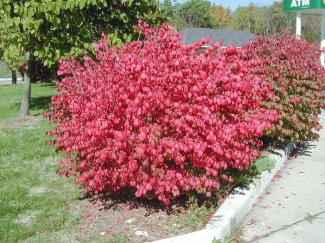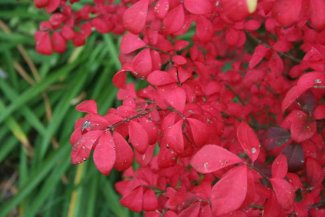Northeastern Asia to Central China and Japan.
Euonymus alatus 'Compactus' is a deciduous, woody shrub approximately 3 m tall and 3 m wiide at maturity wlith a finer, denser branching habit than the species. Twigs are develop 2-4 corky ridges although these tend to be less prominent than on the species. Leaves are opposite to subopposite elliptic to obovate, 2.5 - 8.0 cm long and 1.3 - 3.2 cm wide, and medium to dark green in color, turning brilliant red in the fall. Yellow-green, non-conspicuous flowers apper in May. Fruit is a pinkish-red capsule that ripens in September-October and dehisces to reveal an orange-red aril containing a single seed. The seeds are often eaten and distributed by birds. The species is adaptable to a range of soil types and conditions. It grows well in full sun and can tolerate heavy shade. The cultivar 'Compactus' has been widely planted in the United States in USDA Hardiness Zones 4 to 8.
The species was first introduced to the United States around 1860 and has since been widely planted throughout much of the eastern and midwestern United States. It is highly valued for its dense, symmetrical habit, attractive clean, green summer foliage, interesting corky twigs, and brilliant red foliage and showy orange arils in the fall. Date of selection and introduction of the cultivar 'Compactus' are unknown but it has been a popular ornamental plant for more than several decades.

